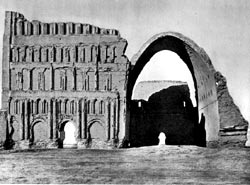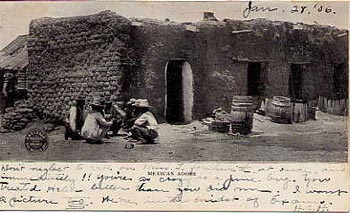One of the most intriguing monuments still standing in Iraq is the Ziggurat at Ur. A ziggurat is a colossal stepped platform; and it is thought that ziggurats supported temples at their tops. These ziggurats were built during the third millennium B.C. Archaeologists don’t know for certain what the purpose of these ziggurats was; however, it is speculated that they had some connection with religion. There are several ziggurats visible throughout Iraq, the most famous of which is the ziggurat at Ur in the south of Iraq. The core of the ziggurat at Ur was constructed using mud bricks which were then covered with baked bricks. The mud bricks were made out of mud and reed; the reed was pressed into moulds that had been left to dry in the sun. Each brick measured around 25 x 16 x 7 centimeters and weighed around 4.5 kilograms.
Ctesiphon Arch

The Ctesiphon arch is considered as one of the many architectural wonders of Mesopotamia. This arch was built in 400 A.D. by the Parthian Persians to be the largest single-span vault of un-reinforced brickwork in the world. The arch has a span of seventy-five feet and is about 110 feet high.It stands in the ancient city of Ctesiphon. Ctesiphon is a historically significant city that lies on the east bank of the Tigris River just south of Baghdad. The Ctesiphon arch is a pointed ovoid peculiar to Mesopotamian architecture; it was built using unfired, thin mud bricks which were laid on a slant.
Afghanistan Unreconstructed

Image from (Afghanistan) Unreconstructed, New York Times Magazine, Sunday 06/01/03
ADOBE CONFERENCE MAY 16 AND 17
The Adobe Association of the Southwest
Northern New Mexico Community College
El Rito Campus in its wonderful old adobe buildings
Friday 16th Dinner/ Reunion and Plenary Session/Keynote Presentations/Dedications
Saturday 17th Presentations/Poster Sessions/Meals Continue reading “ADOBE CONFERENCE MAY 16 AND 17”
Taos

Taos Pueblo. Date unknown
Las Vegas

Out for a Ride. Las Vegas, New Mexico. Circa 1910.
Mexican Adobe

Mexican Adobe, January 28, 1906. Location unknown.
Flagship Class
The flagship class at Northern New Mexico Community College, taught by Quentin Wilson, will be April 28 to May 9 in El Rito, NM. The class is Arches, Domes and Vaults, ADOB 112 and tuition is $54 plus $30 for fees and administrative items. Possible lecturers are Simone Swan and Greg Seelhorst who has 9 years experience in Africa and association with John Norton’s Woodless Construction. For more information visit the Quentin Wilson Website.
Church in Tucson

Old Adobe Church, Old Tucson, Tucson Mtn. Park. Tucson Arizona. Date unknown.
Mexican Adobe Home

The title of this photo postcard reads, “Mexican adobe home with bake ovens in front”. Date unknown. Possibly New Mexico.
